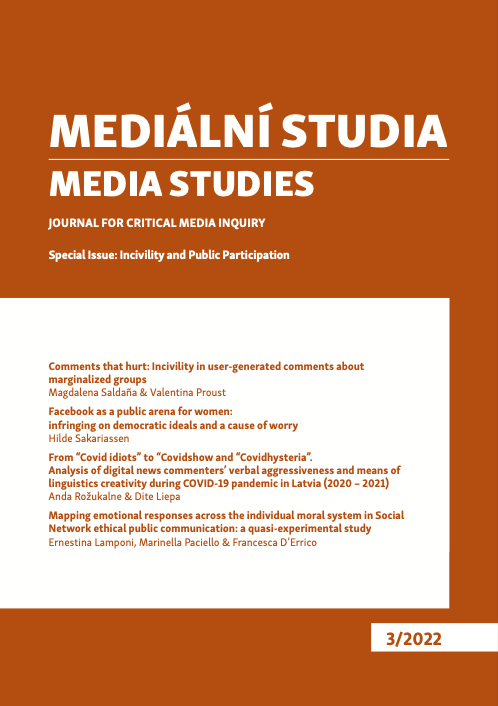From “Covid idiots” to “Covidshow and “Covidhysteria”
From “Covid idiots” to “Covidshow and “Covidhysteria”
Analysis of digital news commenters’ verbal aggressiveness and means of linguistics creativity during COVID-19 pandemic in Latvia (2020 – 2021)
Author(s): Anda Rožukalne, Dite LiepaSubject(s): Media studies, Applied Linguistics, Communication studies
Published by: Univerzita Karlova v Praze, Fakulta sociálních věd
Keywords: digital media users’ comments; verbal aggressiveness; linguistic creativity; COVID-19; pandemic; Latvia
Summary/Abstract: The main objective of this interdisciplinary study is to find out if verbal aggressiveness expressed by news commenters on the three largest digital news media (delfi.lv, tvnet.lv, apollo.lv) in Latvia fosters COVID-19 pandemic-related linguistic creativity during two state of emergency periods in Latvia (2020 – 2021). Did the commenters’ dissatisfaction with the course of the pandemic and their response to the news of the pandemic contribute to the creation of new words related to COVID-19? Using data provided by the Index of the Internet Aggressiveness (IIA), a research tool, and employing content analysis to evaluate the comments and pandemic-related words used in the comments, the study concludes that as the level of aggressiveness of commenters spikes, the use of COVID-19-related aggressive keywords and the number of new pandemic-related words increases as well. However, the aggressive words associated with COVID-19 account for a small proportion of commenters’ aggressiveness and incivility during pandemic. The most widely applied word-formation pattern to coin COVID-19 related words is the syntactic word-formation pattern, allowing the commenters to quickly create compound words, one part of which relates to COVID-19, while the other part expresses their attitude and assessment of the pandemic realities. Most of the new words are used only once and do not become a stable part of the commenters’ vocabulary, thus showing the variability, instability, and fragmented character of communication in digital public sphere.
Journal: Mediální studia
- Issue Year: 16/2022
- Issue No: 03
- Page Range: 329-360
- Page Count: 32
- Language: English

